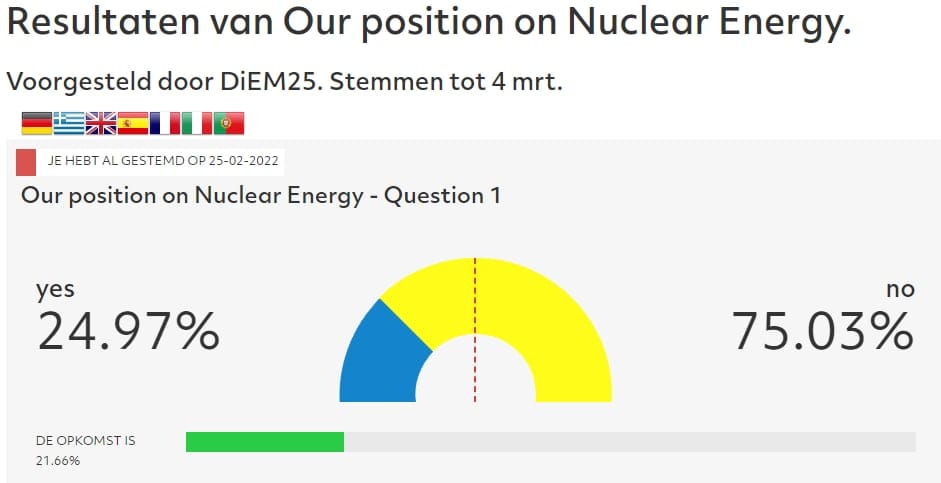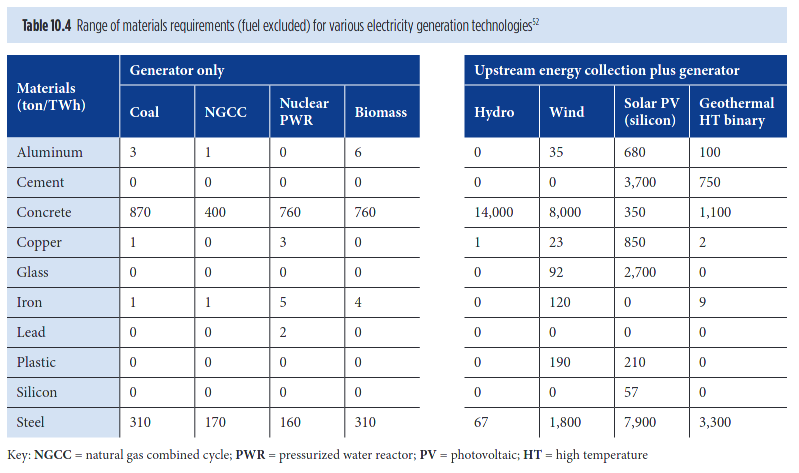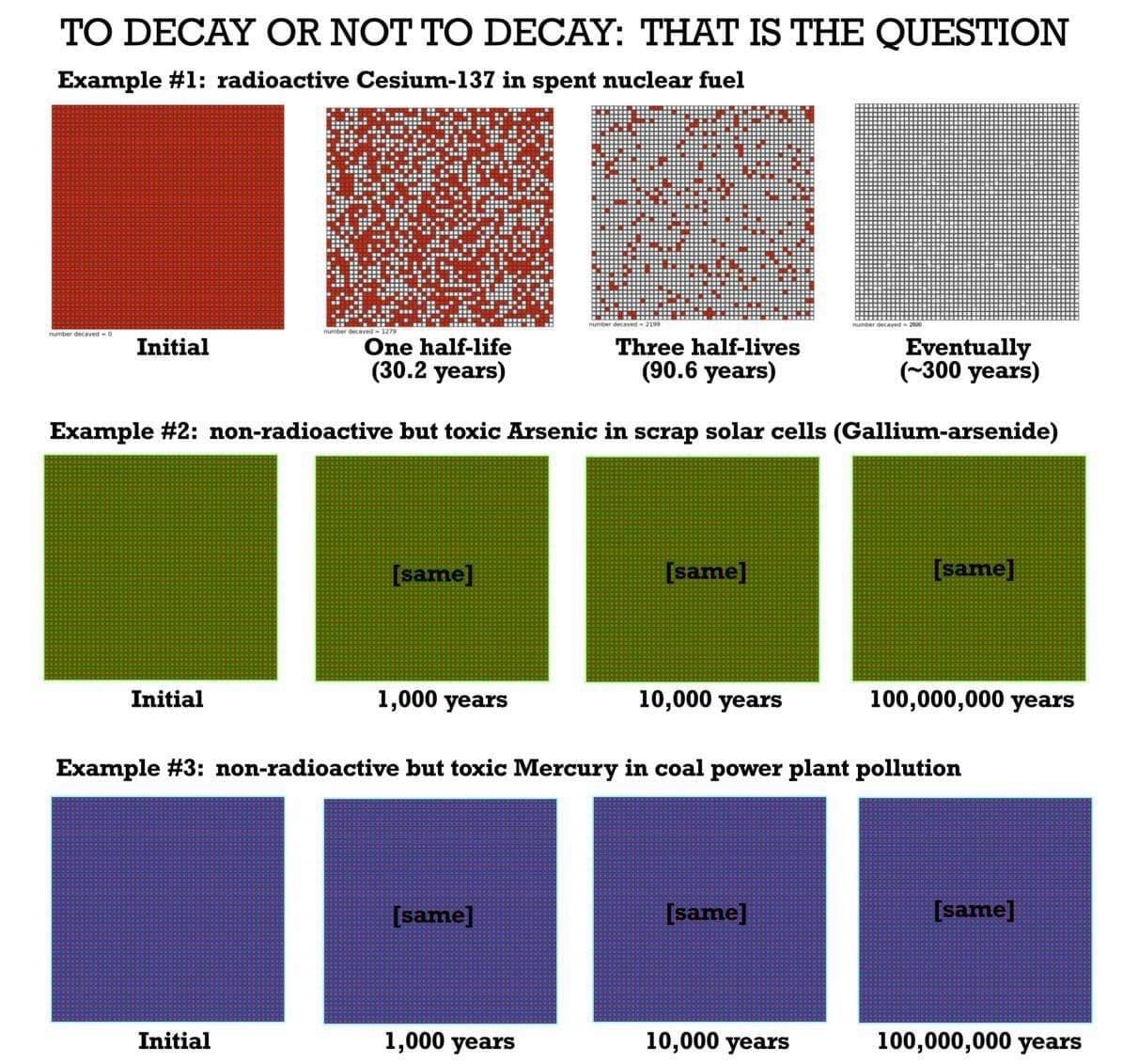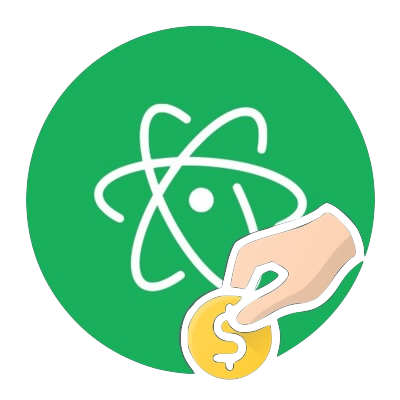Nuclear is green

Today the 'Democracy in Europe Movement 2025' (DiEM25) launched a campaign against nuclear power titled 'Don't paint it green'. This article is a response to the arguments DiEM25 raises against nuclear energy. It critiques the cliched and unscientific approach and its silence on the issues with 'green' alternatives.
Last month, DiEM25 held a so called 'all member vote', which is a digital poll on the internal members-only website of DiEM25. As a passive member in the Netherlands, a country with barely any structures of the organisation, I voted but didn't participate in the discussion. As I expected, the sad outcome was an overwhelming rejection of nuclear energy:

This clear result seems to have been the basis not only of the current campaign, but also the tone which appears almost fanatically against. In this piece I reply to the points being made by DiEM25 against nuclear energy and raise other issues they choose to ignore. The text is setup in concise points, which we'll quote here:
First, the risks are enormous. At any time, especially with the rising levels of climate uncertainties, let alone human errors, damage in nuclear power plants can result in catastrophes such as one in Fukushima or Chernobyl. Nuclear reactors are, in the best case, designed to withstand a single earthquake measuring a maximum of 7.0 magnitude on the Richter scale. But if faced with several minor ones — or damage to surrounding infrastructure — the power plant will be destroyed. Due to man-made climate change, we can only expect rising sea levels, hurricanes, and other climate disasters. We cannot expect the Earth to stand still in these uncertain times.
Tectonic fault lines are well documented and geographically limited. Some fault lines are known to have earth quakes, others do not. The simple answer here is: don't build a nuclear reactor on or near a fault line. Given that we're talking about Europe here, this should leave us with ample possibilities to place reactors.
Specifically speaking about Fukushima, the operator TEPCO removed a natural 35m seawall that would've protected the plant when building it in the 1960's. It was replaced with a barrier that was unfit for duty. Furthermore, most of the emergency diesel generators to keep the cooling pumps going were located in the basement and, as such, flooded when the tsunami hit. See this extensive dossier over at the World Nuclear Association for more details. Despite these rather stupid design decisions, it has to be stressed that no one died because of the core meltdown at the plant or the leaked radiation, which quickly dissipated. All casualties were a direct result of the tsunami or a result of the mass panic and evacuation because of the fear for a meltdown.
This brings us to a first set of conclusions: 1. radiophobia, the unfounded fear for radiation in relation to nuclear energy, kills. Much like yelling "fire!" in a full theater room, it caused mass panic and stress. 2. we learn from past mistakes. The Japanese have restarted their nuclear power plants again, even put them front and center in their strategy of moving to zero carbon, but made all of their plants much safer.
Chernobyl is also mentioned in passing. We've written about that disaster in our FAQ, but suffice to say that the technology used in that plant isn't used at all in Europe. A Chernobyl-like disaster cannot happen in Europe, quite simply because we don't have the RBMK reactors which were fundamentally unsafe.
Secondly, consumed fuel rods from nuclear plants are radioactive waste. And they are often stored at the same site as the reactor. This radioactive waste has to be maintained for at least 200,000 years (!) and the more nuclear waste there is, the higher the chance that leaks will occur. This can damage human, non-human animals and the planet itself.
Nuclear 'waste' is not an issue. Again, we refer to our FAQ for a more extensive answer, but in a nutshell most of this 'waste' is actually unused fuel that can be used in future designs like the Chinese molten salt reactor technology or the European MYRRHA. The resulting actual waste will be dangerous for around 300 years before dropping to levels of background radiation, something which we can realistically store. Quite the difference from the scary number of 200,000 years! Furthermore, the size of this amount of waste is tiny compared to all other resources!
Can we really trust our governments with this issue? What are the chances that the previously mentioned case of Fukushima, where the authorities decided to dump more than a million ton of radioactive waste water in the Pacific Ocean, won’t be replicated all over the world?
Again, DiEM25 counts on your fear of 'nuclear waste water' to get into line. What is this 'waste water'? As this helpful wiki article describes, this is water contaminated with tritium, an isotope of hydrogen. This isotope does occur in nature and has a half-life of about 12 years. In other words: the water now is about half a radioactive as it was during the incident. When it is finally fully released into the Pacific in 30 years, it'll be 6% as radioactive as it was originally. How radioactive is it?
The American Council on Science and Health had this to say about it: "Radioactivity is measured by the rate at which it decays. One Becquerel or Bq is that amount of any radioactive material that will undergo one radioactive decay every second. According to a report developed in 2016 looking specifically at tritiated water from Fukushima, there are about 820,000 cubic meters of water (328 Olympic-sized swimming pools ) containing about 760 trillion Becquerels (760 TBq) of tritium.
"The Pacific Ocean is fairly large – the North Pacific, the location of this discharge, holds 331 million cubic km of water. This is 400 billion times as voluminous as the water being held at Fukushima. If we mix the 760 TBq of tritium into 331 million billion cubic meters of water, we end up with a tritium concentration of 0.0023 Bq of tritium per cubic meter of water. This is not enough to hurt anybody – or any creature living in the water."
Thirdly, new nuclear power costs about 4 times more than wind and solar power per kWh and it’s not renewable at all. In fact, it produces 13 times the emissions per unit of electricity generated compared to windmills. Furthermore, we simply do not have time to make a just transition to carbon-free electricity if we are going to pursue it through nuclear energy.
A lot to unpack here! Regarding costs: the linked website is Deutsche Welle, a well known agitator against nuclear power. Let's take a calculator and go through this, shall we? Let’s take Flamanville 3 as an example. This is a modern EPR reactor that is currently being build in France and is plagued with huge cost overruns and delays. The cost has risen from €3.3 billion from first inception to €12.7 billion now. Once it is ready, it’ll deliver 1600MW of electricity. With a capacity factor of 90% (meaning it’ll be in production 90% of the time, the other 10% being used for maintenance and refueling) that means about 12.6TWh annually. The life expectancy is 60 years, so the total power generated will be around 750TWh. If you calculate this back to a kWh price, you get about 1.7 Eurocents.
Let’s compare this to solar energy. Solarpark Weesow-Willmersdorf came online in 2020 and produces 187GWh annually and cost €100 million to build. To produce as much electricity as one EPR reactor, you’d need to build 67 of these parks, costing €6.7 billion. The life expectancy of solar panels is about 20 years, so to make the comparison one on one with Flamanville 3, you’ll need to multiply by three, coming to a price of €20.1 billion.
Second claim, regarding it not being renewable: strictly speaking this is true, but also completely irrelevant. With the fissile and fertile material on Earth we could power humanity until the sun dies, billions of years from now. From that kind of time perspective, you could say sun and wind aren't renewable either, as the sun will eventually be 'used up'!
Third claim, it produces 13 times more emissions compared to wind: the United Nations Economic Commission for Europe disagrees. They put it on par with wind in the best case and wind being up to three times more polluting in the worst.
Related, wind actually uses a lot more resources to build, as shown by the Quadrennial Technology Review 2015 (chapter 10, page 390):

Fourth claim, regarding not having enough time: compared to what? Solar and wind? Of course, if we'd invest massively in those technologies, we'd need huge investments in the power grid, extending this to facilitate decentralised power generation. This takes many billions of Euros and decades in time. Not enough time?
One nuclear power station takes between 10 to 19 years to build...
The median time to build a new reactor in 2020 was 84 months. Now, in Europe it is true that the average has been higher. This is because, quite simply, we haven't been building many in recent decades. When the French had their Messmer-plan, they build dozens of reactors in the timespan of about twenty years, building up a highly specialised workforce, building a standardised design over and over very efficiently. The new EPR design in contrast has been somewhat of a tragedy. This design was a cooperation between the French EDF and the German Siemens. However, after the 'Atomausstieg' Siemens decided to simply quit their participation, causing lots of delays on the EPR builds. The EDF, having learned from this, came up with a strongly simplified EPR2 design which will now be built with new projects. It stands to reason that if we had a European building project aiming at decarbonising our society with this design, we could be building these units in 84 months or less!
We need to keep in mind that — ultimately — fuel for nuclear power requires mining. However, uranium mining is dangerous. And, unlike renewable energy sources (e.g. silver for windmills) it needs continuous mining. Additionally, uranium mining comes with a whole range of mining related diseases, not to mention that it represents a form of neocolonialism (extracting valuable minerals and destroying the planet and local communities).
Yes, mining is an issue. But so is mining for the resources that make solar panels, wind turbines, lithium-ion batteries, but also computer parts, iPhones, and so on. Mining is an inherent part of our existence as a society. We need to make mining safer and well paid. This is not an argument against nuclear energy.
We should bear in mind that ‘civilian’ nuclear energy programmes supply the necessary plutonium and tritium for nuclear weapons and have historically been used to further military goals.
Like all technology, it can be used in a military sense. But let's not conflate nuclear power with nuclear bombs. While related, the technologies involved are very different. In fact, it would be very hard if not impossible to create a bomb using a civilian reactor. This non-proliferation is extended to "physically impossible" with new fourth generation reactors, like a molten salt reactor.
We cannot simultaneously call for an end to nuclear weapons but support expansion of nuclear energy on our shared planetary home.
Yes we can, and we should.
Last but not least, nuclear energy cannot be created as part of the commons, due to the high need for expertise, security and complicated ways to obtain licenses.
This is an argument against a complex society as such. Because a rail network, the internet or the education system require expertise, security and 'complicated ways to obtain licenses' (whatever that means?), we ought to abolish them? This is a ridiculous argument. The problem, as with the EU, is about accountability, transparency, and democracy. Let's fight to achieve those goals.
... where could things go wrong?
Let's take these concluding words from the statement and have a look at solar and wind. Where could things go wrong?
- Solar and wind take too long to implement: putting solar panels on the roof of your house is a day's work, but what about society the size of Europe? Turns out it would take decades to convert the power grid to go from a 'tree' structure - where you have thick cables with power plants to smaller 'branches' in neighbourhoods - to a decentralised grid what is needed for solar and wind. In Germany alone this is expected to cost up to €110 billion by 2050. In contrast small modular reactors, like the Rolls Royce design, can be built on the location of current coal and natural gas plants without any serious investment in the grid.
- Solar and wind are expensive: the LCOE (levelised cost of energy) is a measure of the cost of a power sources divided by its lifespan. This measure is often used by proponents of solar and wind to claim it is cheaper than nuclear. However, this is a blatant lie. It is important to understand how the LCOE is calculated and once you do, you'll quickly notice how nuclear has all costs 'included' (as it should), whereas solar and wind have many costs 'excluded'. For example, the investments and extra maintenance of a decentralised power grid? Not calculated for solar and wind. The energy storage needed in the order of TWh? Well, the technology doesn't quite exist yet, so let's exclude that too... Yeah, no wonder it is 'cheaper'. LCOE is a great tool for capitalist investors, but you, the consumer, will eventually foot the bill. Solar and wind are way more expensive than nuclear.
- Solar and wind is polluting: not only do solar and wind pollute more than nuclear power during their own lifetime, it is also backed by natural gas plants that serve to fill the gaps for when the sun isn't shining and the wind isn't blowing (or blowing too hard). This means that solar and wind have been and will be reliant on the fossil industry for decades to come. A route to a sustainable future?
- Solar and wind kill: as the National Bureau of Economic Research researched the phase out of nuclear power in Germany, it came to a shocking conclusion: "Put another way, the phase-out resulted in more than 1,100 additional deaths per year from increased concentrations of SO2, NOx, and PM. The increase in production from hard coal plants is again the key driver here, making up roughly 80% of the increase in mortality impacts." This is about 22 times more than the total death count of Chernobyl, repeated every single year!
- Solar and wind are unreliable: solar PV only have a capacity factor of around 10% in Europe and wind on land only reaches about 25%. Wind at sea has a higher capacity factor, but also tops at around 40%. Modern nuclear power plants in contrast can easily reach up to 95%, only shutting down for refueling once every 18 to 24 months. Fourth generation plants, like molten salt reactors, could reach near 100% as they don't need to be shut down for refueling.
- Solar and wind can only provide a small fraction of the energy: production of primary energy in the European Union totalled 24 027 Petajoule (PJ) in 2020. This is mostly heat. Electricity amounted for 2778TWh (or 10,000PJ). While nuclear is an ideal source of both heat and electricity, the same can not be said for solar and wind, without significant losses in conversion.
- Solar and wind don't scale well: as explained in our FAQ, we'd need a huge area of up to 70,000 km² of solar panels to just cover our electric needs. In the case of the Netherlands we'd need around 138,000 wind turbines to cover primary energy.
- Solar and wind pollute after their decommissioning: lithium batteries last for 10 to 15 years, solar panels for 20 to 25 and wind turbines up to 30. So, besides all the resources, time and energy put into creating all this power generation, we'll have to repeat the whole ordeal every few decades. After all is said and done, you furthermore have real issues recycling this junk. Wind turbines have composite materials that can't currently be recycled at all and the EU put out a guideline of recycling solar panels up to 85%. Good, but those 15% remaining still amount to a whole lot of crap! Junk that furthermore doesn't simply dissolve over time. To make this point, another picture:

So please, let's cease this anti-nuclear nonsense and putting our faith in the false prophets of solar and wind. Sure, solar and wind have an application in very specific areas, like remote communities. But the idea of transitioning our society to these forms of energy is ill thought out.
To put it bluntly: the future is nuclear, or we don't have a future.
 Do you value this free article? Please consider a onetime donation or subsribe to read all of my content. Thank you!
Do you value this free article? Please consider a onetime donation or subsribe to read all of my content. Thank you!